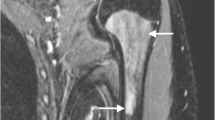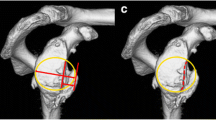Abstract
Purpose
To assess the MRI features of growth plate injury at the base of the coracoid process.
Materials and methods
Subjects were identified through retrospective search of our department imaging database and teaching files and the teaching files of two outside academic institutions. The coracoid base growth plate was examined with attention to widening, irregularity, abnormal signal intensity of the growth plate, and the presence of adjacent soft tissue edema. The apposing coracoid and scapular bony surfaces were examined for signal intensity and morphology.
Results
Shoulder MRIs in eight patients with coracoid base growth plate disturbances were retrospectively reviewed (7 males, 1 female, mean age 15 years). Growth plate injury manifested as widening, irregularity and increased signal, apposing bony marrow edema and hypertrophy, and surrounding soft tissue edema. Five subjects were athletes (football, archery, basketball, swimming, rugby), two had a history of neuromuscular disorders, and one subject presented after a fall. Clinical indications included: rule out labral tear (n = 3), rule out rotator cuff tear or fracture after fall (n = 1), nonspecific pain (n = 1), shoulder subluxation, rule out glenoid pathology (n = 1, patient with underlying neuromuscular disorder), muscular dystrophy with shoulder pain (n = 1), and impingement (n = 1). Coracoid growth plate injury was not suspected clinically in any of the patients.
Conclusion
Awareness of the imaging appearance of coracoid base growth plate injury can aid in a more accurate diagnosis of shoulder MRI studies in young pediatric athletes. While uncommon, coracoid growth plate injury should be considered when assessing children with shoulder symptomatology.



Similar content being viewed by others
References
Harsha WN. Effects of trauma upon epiphyses. Clin Orthop. 1957;10:140–7.
Bedoya MA, Jaramillo D, Chauvin NA. Overuse injuries in children. Top Magn Reson Imaging. 2015;24(2):67–81.
Caine D, DiFiori J, Maffulli N. Physeal injuries in children's and youth sports: reasons for concern? Br J Sports Med. 2006;40(9):749–60.
Ogden JA, Phillips SB. Radiology of postnatal skeletal development. VII. The scapula. Skelet Radiol. 1983;9(3):157–69.
Scheuer L, Black S. Developmental juvenile osteology. 1st ed. San Diego: Elsevier Academic Press; 2000.
Boyer DW Jr. Trapshooter's shoulder: stress fracture of the coracoid process. Case report. J Bone Joint Surg Am. 1975;57(6):862.
Sandrock AR. Another sports fatigue fracture. Stress fracture of the coracoid process of the scapula. Radiology. 1975;117(2):274.
Chammaa R, Miller D, Datta P, McClelland D. Coracoid stress fracture with late instability. Am J Sports Med. 2010;38(11):2328–30.
Resnick D. Diagnosis of bone and joint disorders. 4th ed. Philadelphia: W.B. Saunders Company; 2002.
Delgado J, Jaramillo D, Chauvin NA. Imaging the injured pediatric athlete: upper extremity. Radiographics. 2016;36(6):1672–87.
Ogden JA. Radiology of postnatal skeletal development. XII. The second cervical vertebra. Skelet Radiol. 1984;12(3):169–77.
Ponseti IV. Growth and development of the acetabulum in the normal child. Anatomical, histological, and roentgenographic studies. J Bone Joint Surg Am. 1978;60(5):575–85.
Trueta J, Amato VP. The vascular contribution to osteogenesis. III. Changes in the growth cartilage caused by experimentally induced ischaemia. J Bone Joint Surg Br. 1960;42-B:571–87.
Laor T, Hartman AL, Jaramillo D. Local physeal widening on MR imaging: an incidental finding suggesting prior metaphyseal insult. Pediatr Radiol. 1997;27(8):654–62.
Shih C, Chang CY, Penn IW, Tiu CM, Chang T, Wu JJ. Chronically stressed wrists in adolescent gymnasts: MR imaging appearance. Radiology. 1995;195(3):855–9.
Song JC, Lazarus ML, Song AP. MRI findings in little leaguer's shoulder. Skelet Radiol. 2006;35(2):107–9.
Laor T, Wall EJ, Vu LP. Physeal widening in the knee due to stress injury in child athletes. AJR Am J Roentgenol. 2006;186(5):1260–4.
Jaramillo D, Laor T, Zaleske DJ. Indirect trauma to the growth plate: results of MR imaging after epiphyseal and metaphyseal injury in rabbits. Radiology. 1993;187(1):171–8.
Osier LK, Marks SC Jr, Kleinman PK. Metaphyseal extensions of hypertrophied chondrocytes in abused infants indicate healing fractures. J Pediatr Orthop. 1993;13(2):249–54.
Ogden JA. Growth slowdown and arrest lines. J Pediatr Orthop. 1984;4(4):409–15.
Grogan DP, Love SM, Ogden JA, Millar EA, Johnson LO. Chondro-osseous growth abnormalities after meningococcemia. A clinical and histopathological study. J Bone Joint Surg Am. 1989;71(6):920–8.
Alberty A, Peltonen J. Proliferation of the hypertrophic chondrocytes of the growth plate after physeal distraction. An experimental study in rabbits. Clin Orthop Relat Res. 1993;297:7–11.
Apte SS, Kenwright J. Physeal distraction and cell proliferation in the growth plate. J Bone Joint Surg Br. 1994;76(5):837–43.
De Bastiani G, Aldegheri R, Renzi Brivio L, Trivella G. Chondrodiatasis-controlled symmetrical distraction of the epiphyseal plate. Limb lengthening in children. J Bone Joint Surg Br. 1986;68(4):550–6.
Stein-Wexler R, Wootton-Gorges SL, Ozonoff MB (eds). Pediatric orthopedic imaging. Berlin: Springer-Verlag; 2015.
Winfeld M, Rosenberg ZS, Wang A, Bencardino J. Differentiating os acromiale from normally developing acromial ossification centers using magnetic resonance imaging. Skelet Radiol. 2015;44(5):667–72.
Roedl JB, Morrison WB, Ciccotti MG, Zoga AC. Acromial apophysiolysis: superior shoulder pain and acromial nonfusion in the young throwing athlete. Radiology. 2015;274(1):201–9.
Author information
Authors and Affiliations
Corresponding author
Ethics declarations
Conflict of interest
The authors declare that they have no conflict of interest.
Rights and permissions
About this article
Cite this article
Alaia, E.F., Rosenberg, Z.S., Rossi, I. et al. Growth plate injury at the base of the coracoid: MRI features. Skeletal Radiol 46, 1507–1512 (2017). https://doi.org/10.1007/s00256-017-2736-0
Received:
Revised:
Accepted:
Published:
Issue Date:
DOI: https://doi.org/10.1007/s00256-017-2736-0




